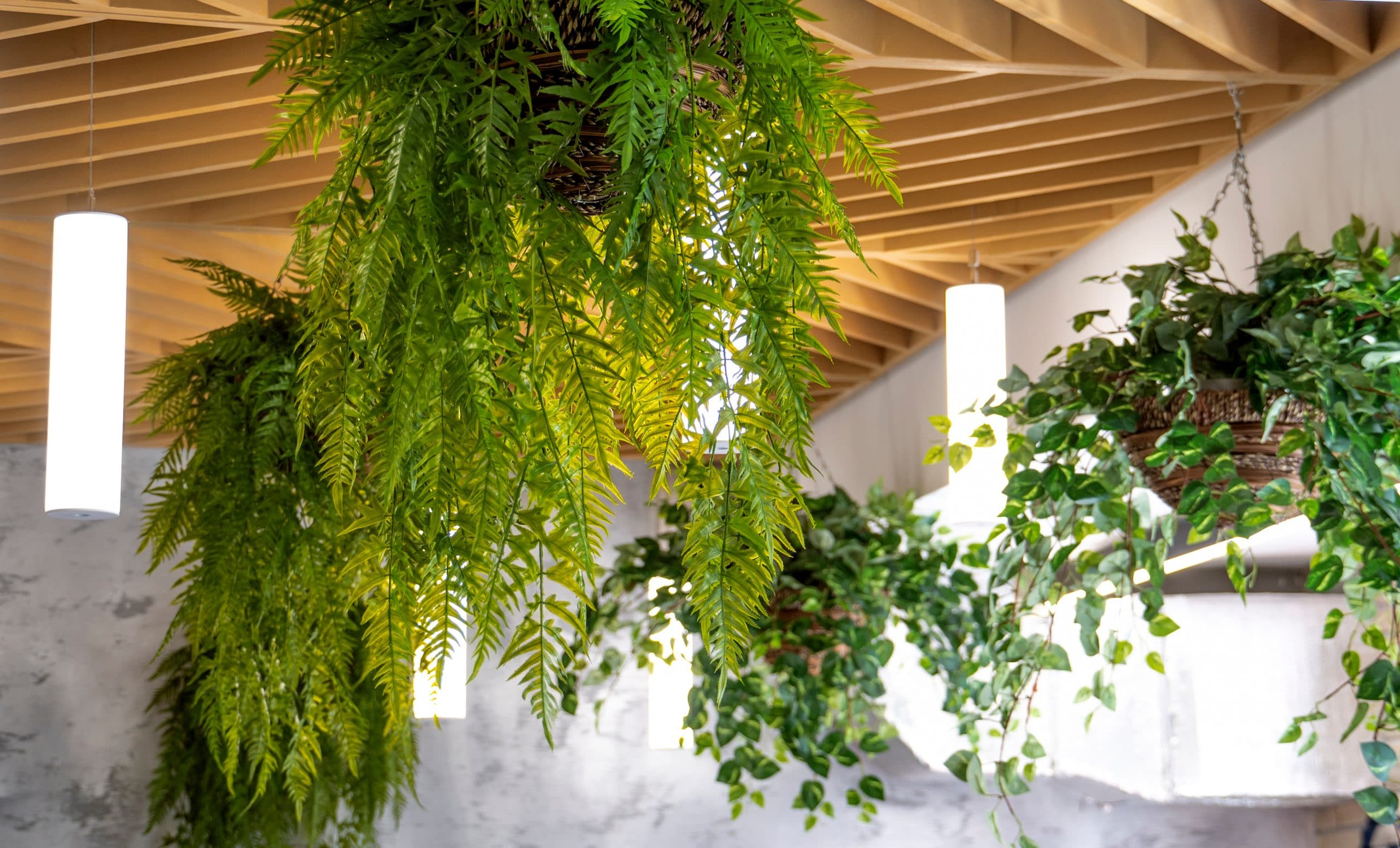Biophilic Design is an exciting concept in the world of construction; one that’s steadily growing in popularity. Here we explore Biophilic Design and just why it’s so important.
Many companies across the world such as Amazon, Google and Apple are investing into adapting their buildings to Biophilic Design. Why? It has been found that incorporating direct elements of nature into building environments can reduce stress, blood pressure and heart rates of occupants whilst also increasing productivity, creativity and well-being.
So, what is Biophilic Design? Biophilic design is a method used within the construction industry to increase occupant connection to the natural environment through the use of direct nature, indirect nature and place conditions.
Biophilic Design can be used in a variety of public buildings and has many benefits such as:
- Increasing productivity in offices
- Calming and restorative in homes
- Improved learning in education centres
- Public is willing to spend more money on buildings that have biophilic elements
Interested? Keep reading to find out more.
What is biophilic design?
Let’s break it down. Biophilia is Latin for ‘Love for Nature’. It focuses on human’s attraction to nature and the natural processes across the globe. Biophilia suggests that we all have a genetic connection to the natural world which has progressed further through hundreds and thousands of years.
However, it is suggested that humans spend 93% of their time indoors separated from nature and natural elements. We are stuck inside! This is where Biophilic Design comes into play. Biophilic Design helps to connect our love of nature within the modern building environment. It allows us to focus on aspects of the natural world that help to improve human health and productivity. And we know how hard that can be in today’s society.
Biophilic Design works in different ways and has three categories to consider:
Nature in the space
The direct presence of nature such as plants, animals, water, breeze, scents, light, shadows and other natural elements in the space.
Natural Analogues
This includes the use of natural materials patterns, objects, colours and shapes being embodied into building design, facade, decor and furniture.
Nature of the space
Now, this one is pretty neat. Nature such as expansive views, places of sensory refuge such as a dark room that imitates a cave or a mild sense of risk such as stepping stones over a shallow pond can be used across the building.
Why is biophilic design so prolific today?
There has been a huge amount of research proving that nature in our homes and workplaces improves our sense of wellbeing. We all have to admit, modern life is hard and stressful with the majority of us spending way too much time stuck in doors, in front of numerous screens. Biophilic Design helps us as humans to reconnect with nature and the outdoors which of course, helps to boost happiness and health.
According to a recent study conducted by Wang et al., 2020 when COVID-19 struck and forced people to stay inside, this lifestyle change disrupted everyone’s wellbeing and health. This resulted in 60% of people experiencing depression, 53% of people experiencing sleep disturbance and 46% having increased irritability. These are scary figures…. As humans, we crave fresh air and to be connected to nature’s core. Being stuck inside is not healthy, but when it’s necessary to spend your time inside, this is where Biophilic Design can be so fundamental to improving people’s lives for the better.
Scientists at Aarhus University in Denmark have found that being raised near green space can decrease the risk of developing mental health problems by 55%. Taking this into consideration, Biophilic Design can help:
- Increase productivity
- Promote calmness by reducing heart rates and stress levels
- Improve learning by increasing concentration
- Improve mental health
- Reduce pain
- Improve air quality
And so much more! It also makes your building look amazing. What’s not to love?
Want to find out more about architecture and how it affects your mental health? Check out previous blog ‘3 Wellbeing and Architectual Design Books to Add to Your Bookshelf’
What are the six features of biophilic design?
Bilophilic sounds great, but how do you implement it into your own workplace or home? There are six features of Biophilic Design to remember:
- The Natural Environment
This feature focuses on the natural world. Things such as earthy colours, sunlight, plants and images of animals or nature are implemented into an office setting or home.
- Natural Shapes
Natural shapes can be seen as lines, shapes and forms that occur naturally in nature. For context, examples include arches, vaults, rock shelves and water paths.
- Natural Patterns
Similarly to natural shapes, natural patterns are patterns and processes that occur in nature over a period of time. An example would be the erosion of a rock or growth of plants.
- Plants
We know… There’s such an urge to turn your office into a jungle, but if you focus on slowly introducing real plants, imagery and plant colours to begin to create a strong relationship with the office and natural elements.
- Natural Light
We love a good stream of lighting coming into our buildings because of the effect it can have on your health, happiness and your home. Light helps to bring warmth and different shapes within the rooms.
- Human-Nature Relationship
Overall, this involves recreating the relationship between humans and nature. Biophilic design ties all elements together, helping to bring order, safety, curiosity, affection, discovery and much more into the office and your home.
What does biophilic design mean for the environment?
Of course, this wouldn’t be a Buildpass blog if we didn’t mention sustainable construction! The sustainable aspect of biophilic design is a crucial element for living buildings and environments. Creating green spaces, water features, plants and natural materials brings a range of benefits such as reducing a development’s carbon footprint and regulating temperatures of buildings.
Biophilic design on a budget.
In conclusion, Biophilic design can have some serious positive impact on your health and your home, but can you do it on a budget and avoid spending big bucks? Of course! Here are a few ways you can implement Biophilic Design into your home or workplace on a budget:
Plants
Buy potted plants from your local garden centre or supermarket. You can usually find a good bargain towards the end of spring/summer too!
Switching up your light routine
Harsh lighting can impact our natural circadian rhythm. To avoid this, open your blinds more often to let in more natural light. You can also purchase circadian lamps and light bulbs to mimic natural light.
Water
It has been proven that water elements can help to reduce stress and improve memory. Consider buying a small water feature such as a table-top fountain to implement the sound of falling water into your office or home. This will improve your focus and lower blood pressure.
Upgrade your Furniture
If possible, replace some of your furniture with wooden or bamboo pieces. Mix wood and mental for the best of both worlds!
Can Buildpass help me incorporate biophilic design into my next construction project?
Yes! Get ahead of the game by investing biophilic design into your next project. Click here for a free consultation.




















